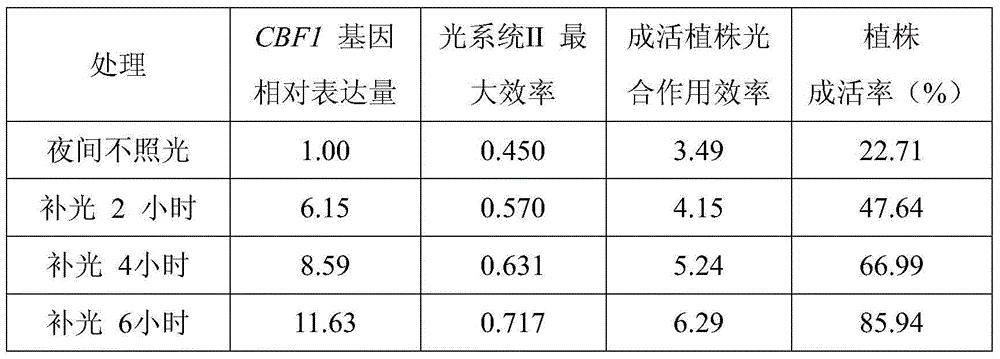Method for inducing tomato to improve low temperature resistance
A tomato and low temperature technology, applied in the agricultural field, can solve the problems of expensive methods of plant resistance to low temperature, changing the flavor and nutritional value of vegetables, and increasing the burden of energy consumption on farmers, so as to improve photosynthesis efficiency and seedling rate, and promote survival. efficiency, reducing energy consumption
- Summary
- Abstract
- Description
- Claims
- Application Information
AI Technical Summary
Problems solved by technology
Method used
Image
Examples
Embodiment 1
[0020] The tomato variety used in the experiment was Ailsa Craig. The seeds were sown in plastic pots filled with a 3:1 peat and perlite compound cultivation substrate. After emergence, water was kept in accordance with the moisture content of the substrate to keep the substrate moist. Hoagland’s nutrient solution was poured throughout the process. When the four leaves are one heart, low-temperature treatment is carried out, and the treatment temperature is 0 degrees during the day and -2 degrees at night.
[0021] Four treatments were set up in the experiment: 1) control group (no light treatment at night); 2) 10 μmol m -2 the s -1 Far-red light treatment; 3) 20 μmol m at night -2 the s -1 Far-red light treatment; 4) 30 μmol m at night -2 the s -1 Far-red light treatment. 8 hours of lighting treatment at 20PM-6AM at night, and 72 hours of low temperature treatment. Immediately after the low temperature treatment, samples were taken to measure the expression of CBF1 gene...
Embodiment 2
[0035] The tomato variety used in the experiment was Zheza No. 5. The seeds were sown in plastic pots filled with a 3:1 peat and perlite composite cultivation medium. After emergence, water according to the moisture content of the substrate to keep the substrate moist. During the whole process, Hoagland nutrition was poured. Liquid, when the four leaves are one heart, carry out low temperature treatment, the treatment temperature is 0 degrees during the day and -2 degrees at night.
[0036] Carry out plant culture according to the exactly same culture mode as Example 1, establish 4 processings: 1) control group (no light treatment at night); 2) 20 μ mol m -2 the s -1Far-red light treatment, the treatment time is 2 hours (12PM-2AM); 3) 20μmol m at night -2 the s -1 Far-red light treatment, the treatment time is 4 hours (12PM-2AM, 4AM-6AM); 4) 20μmol m at night -2 the s -1 Far-red light treatment, the treatment time is 6 hours (8PM-10PM; 12PM-2AM, 4AM-6AM). The low temperat...
Embodiment 3
[0042] The tomato variety used in the experiment is Hezuo 903. The seeds were sown on November 20 in a seedling tray filled with a 3:1 peat and perlite composite cultivation medium for seedling cultivation. After emergence, water according to the moisture content of the substrate to keep the substrate moist. Pour Hoagland nutrient solution. After the emergence of tomato seedlings, the tomatoes were planted in plastic greenhouses on December 30, and two treatments were set up: 1) the control group (no far-red light supplementation treatment at the adult plant stage); 2) far-red LED night light (adult plant stage) Carry out far-red light supplement light treatment at night). It started on January 5 of the following year, and the supplementary light continued until February 5. Far-red LED bulbs (10 watts / piece) are installed at 50 cm above the tomato plant, and can be raised and lowered. The installation density is 2 pieces / square meter; the wavelength range of far-red light is ...
PUM
 Login to View More
Login to View More Abstract
Description
Claims
Application Information
 Login to View More
Login to View More - R&D
- Intellectual Property
- Life Sciences
- Materials
- Tech Scout
- Unparalleled Data Quality
- Higher Quality Content
- 60% Fewer Hallucinations
Browse by: Latest US Patents, China's latest patents, Technical Efficacy Thesaurus, Application Domain, Technology Topic, Popular Technical Reports.
© 2025 PatSnap. All rights reserved.Legal|Privacy policy|Modern Slavery Act Transparency Statement|Sitemap|About US| Contact US: help@patsnap.com



